LCCA - Strategic Analysis of Tesco: Business Environment Report
VerifiedAdded on 2022/09/05
|11
|2871
|59
Report
AI Summary
This report presents a comprehensive strategic analysis of Tesco, a leading UK retailer, using SWOT, PESTLE, and Porter's Five Forces frameworks. It examines the political, economic, social, technological, environmental, and legal factors impacting Tesco's business environment. The SWOT analysis identifies Tesco's strengths, weaknesses, opportunities, and threats, while Porter's Five Forces assesses the competitive intensity of the grocery market. The report also offers recommendations for Tesco to adapt to the changing business landscape and sustain its market position. The analysis highlights Tesco's reliance on the UK market, its brand strength, and the increasing importance of online grocery retailing. The document concludes by emphasizing the need for continuous adaptation and strategic innovation for Tesco to maintain its competitive edge.
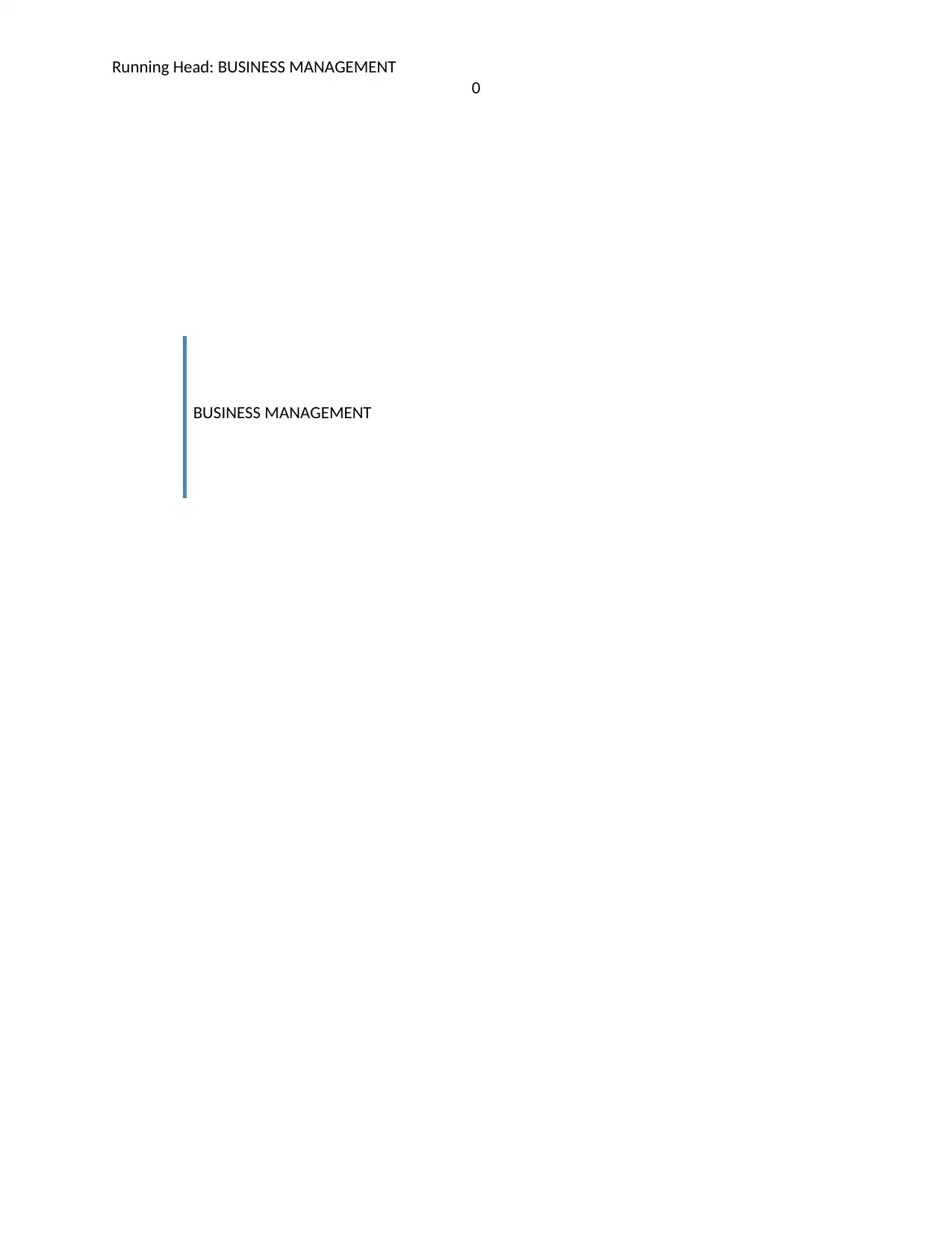
Running Head: BUSINESS MANAGEMENT
0
BUSINESS MANAGEMENT
0
BUSINESS MANAGEMENT
Paraphrase This Document
Need a fresh take? Get an instant paraphrase of this document with our AI Paraphraser
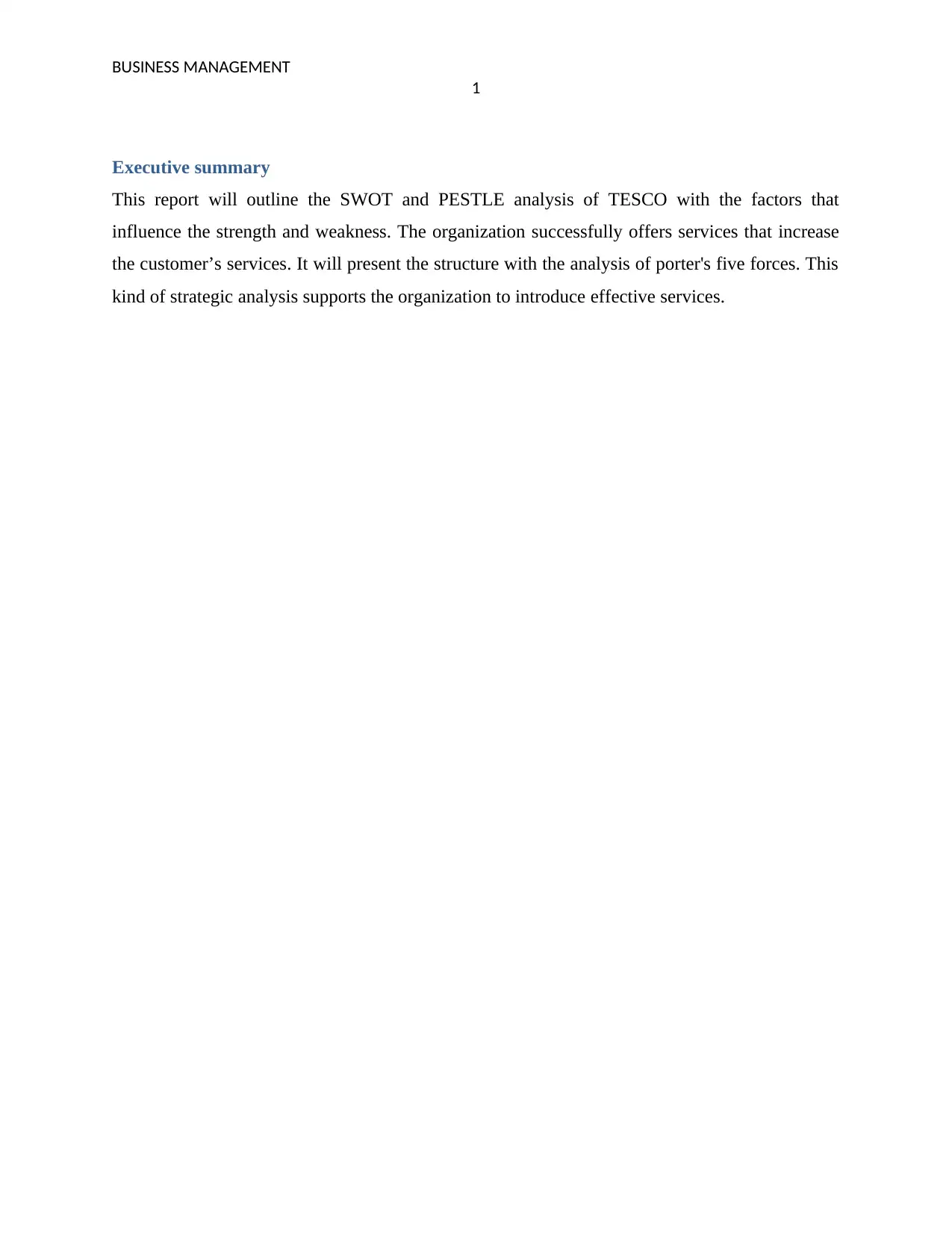
BUSINESS MANAGEMENT
1
Executive summary
This report will outline the SWOT and PESTLE analysis of TESCO with the factors that
influence the strength and weakness. The organization successfully offers services that increase
the customer’s services. It will present the structure with the analysis of porter's five forces. This
kind of strategic analysis supports the organization to introduce effective services.
1
Executive summary
This report will outline the SWOT and PESTLE analysis of TESCO with the factors that
influence the strength and weakness. The organization successfully offers services that increase
the customer’s services. It will present the structure with the analysis of porter's five forces. This
kind of strategic analysis supports the organization to introduce effective services.
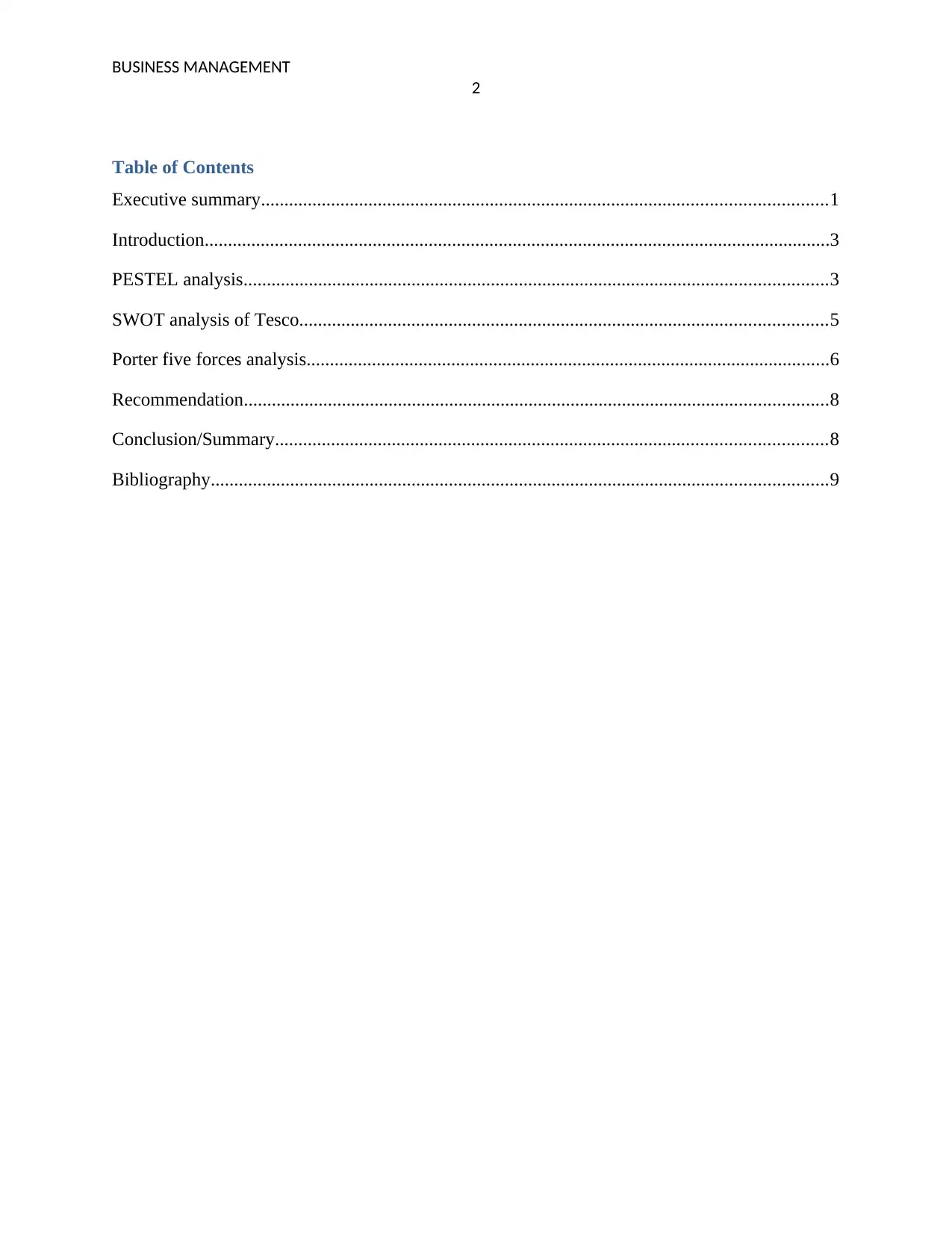
BUSINESS MANAGEMENT
2
Table of Contents
Executive summary.........................................................................................................................1
Introduction......................................................................................................................................3
PESTEL analysis.............................................................................................................................3
SWOT analysis of Tesco.................................................................................................................5
Porter five forces analysis................................................................................................................6
Recommendation.............................................................................................................................8
Conclusion/Summary......................................................................................................................8
Bibliography....................................................................................................................................9
2
Table of Contents
Executive summary.........................................................................................................................1
Introduction......................................................................................................................................3
PESTEL analysis.............................................................................................................................3
SWOT analysis of Tesco.................................................................................................................5
Porter five forces analysis................................................................................................................6
Recommendation.............................................................................................................................8
Conclusion/Summary......................................................................................................................8
Bibliography....................................................................................................................................9
⊘ This is a preview!⊘
Do you want full access?
Subscribe today to unlock all pages.

Trusted by 1+ million students worldwide
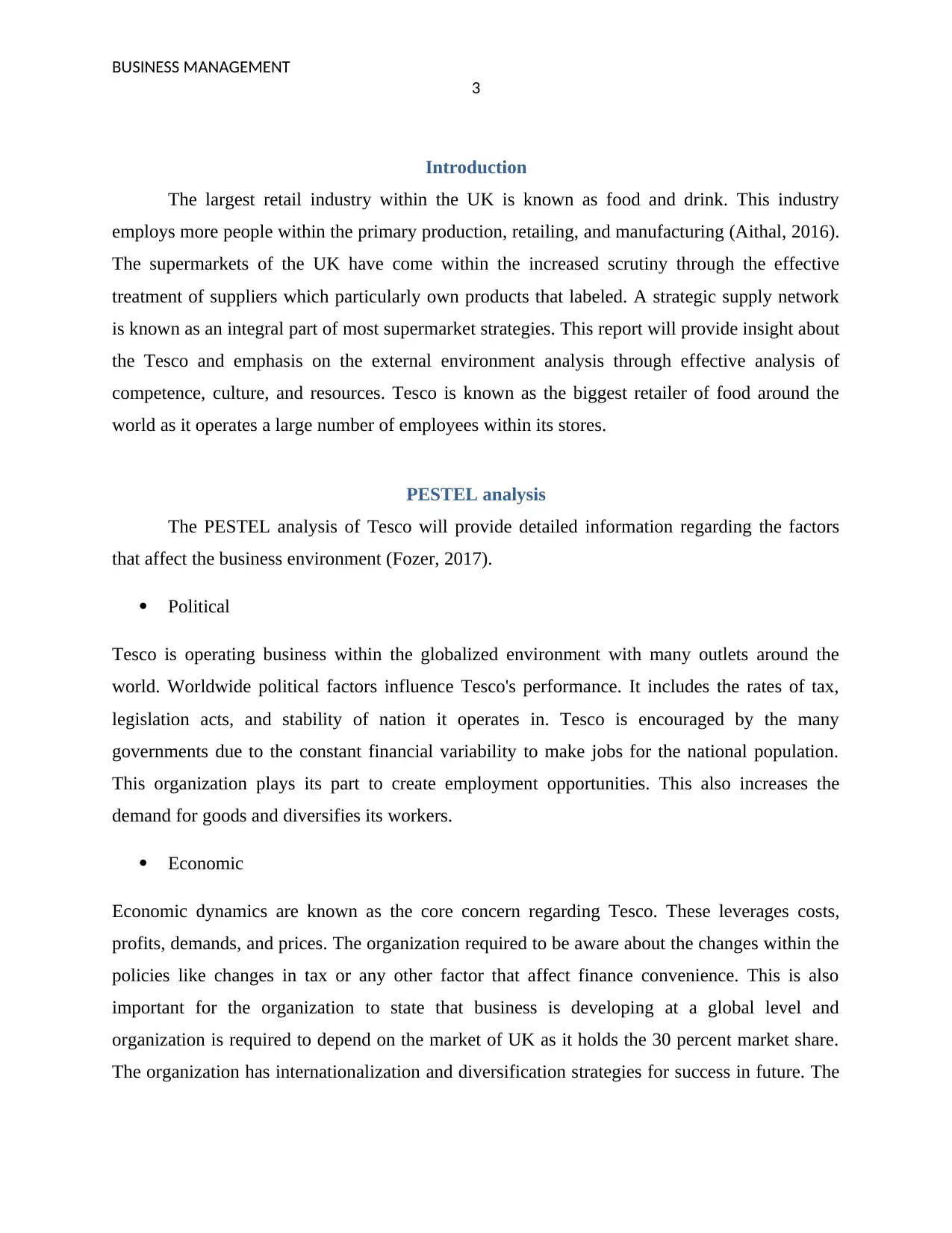
BUSINESS MANAGEMENT
3
Introduction
The largest retail industry within the UK is known as food and drink. This industry
employs more people within the primary production, retailing, and manufacturing (Aithal, 2016).
The supermarkets of the UK have come within the increased scrutiny through the effective
treatment of suppliers which particularly own products that labeled. A strategic supply network
is known as an integral part of most supermarket strategies. This report will provide insight about
the Tesco and emphasis on the external environment analysis through effective analysis of
competence, culture, and resources. Tesco is known as the biggest retailer of food around the
world as it operates a large number of employees within its stores.
PESTEL analysis
The PESTEL analysis of Tesco will provide detailed information regarding the factors
that affect the business environment (Fozer, 2017).
Political
Tesco is operating business within the globalized environment with many outlets around the
world. Worldwide political factors influence Tesco's performance. It includes the rates of tax,
legislation acts, and stability of nation it operates in. Tesco is encouraged by the many
governments due to the constant financial variability to make jobs for the national population.
This organization plays its part to create employment opportunities. This also increases the
demand for goods and diversifies its workers.
Economic
Economic dynamics are known as the core concern regarding Tesco. These leverages costs,
profits, demands, and prices. The organization required to be aware about the changes within the
policies like changes in tax or any other factor that affect finance convenience. This is also
important for the organization to state that business is developing at a global level and
organization is required to depend on the market of UK as it holds the 30 percent market share.
The organization has internationalization and diversification strategies for success in future. The
3
Introduction
The largest retail industry within the UK is known as food and drink. This industry
employs more people within the primary production, retailing, and manufacturing (Aithal, 2016).
The supermarkets of the UK have come within the increased scrutiny through the effective
treatment of suppliers which particularly own products that labeled. A strategic supply network
is known as an integral part of most supermarket strategies. This report will provide insight about
the Tesco and emphasis on the external environment analysis through effective analysis of
competence, culture, and resources. Tesco is known as the biggest retailer of food around the
world as it operates a large number of employees within its stores.
PESTEL analysis
The PESTEL analysis of Tesco will provide detailed information regarding the factors
that affect the business environment (Fozer, 2017).
Political
Tesco is operating business within the globalized environment with many outlets around the
world. Worldwide political factors influence Tesco's performance. It includes the rates of tax,
legislation acts, and stability of nation it operates in. Tesco is encouraged by the many
governments due to the constant financial variability to make jobs for the national population.
This organization plays its part to create employment opportunities. This also increases the
demand for goods and diversifies its workers.
Economic
Economic dynamics are known as the core concern regarding Tesco. These leverages costs,
profits, demands, and prices. The organization required to be aware about the changes within the
policies like changes in tax or any other factor that affect finance convenience. This is also
important for the organization to state that business is developing at a global level and
organization is required to depend on the market of UK as it holds the 30 percent market share.
The organization has internationalization and diversification strategies for success in future. The
Paraphrase This Document
Need a fresh take? Get an instant paraphrase of this document with our AI Paraphraser
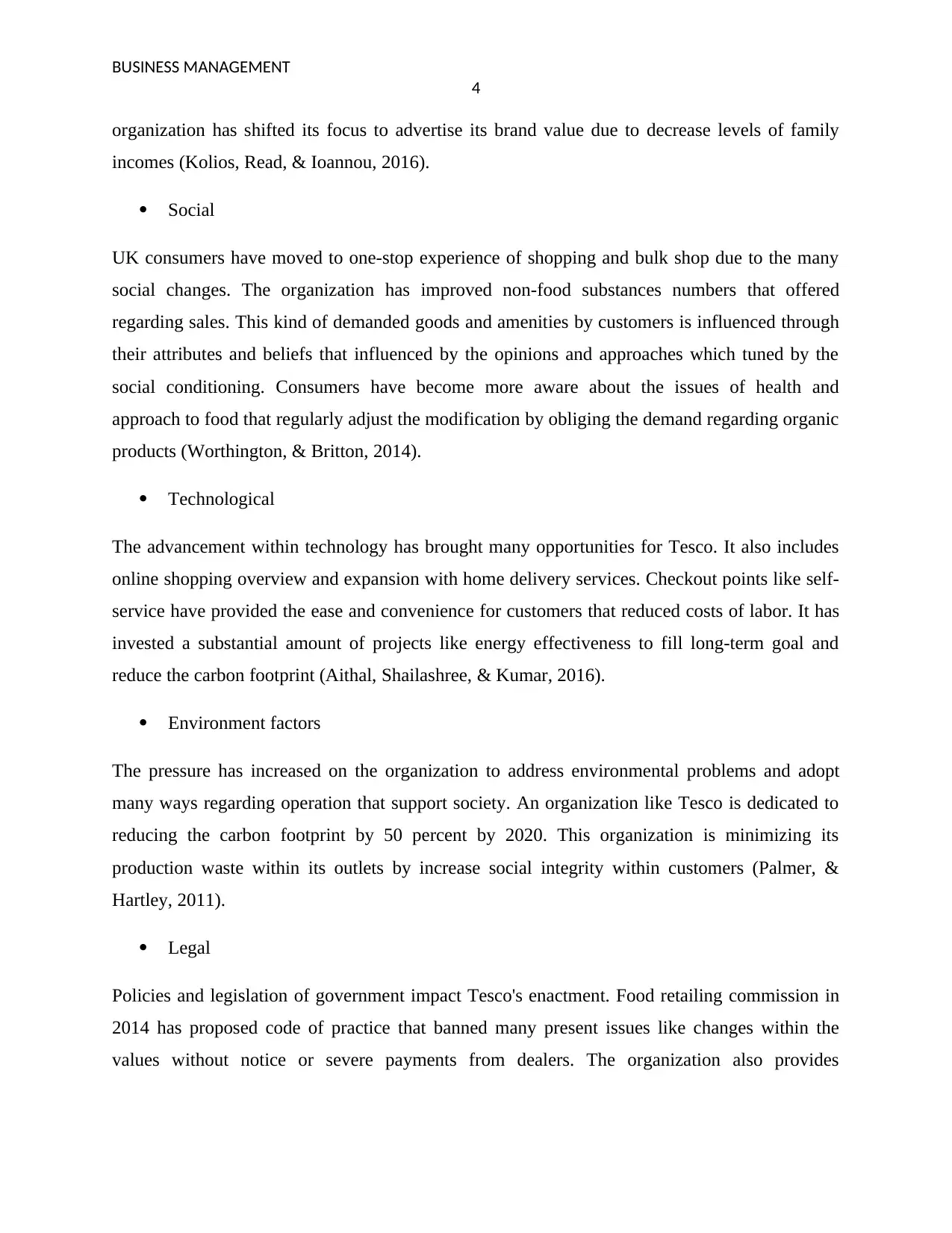
BUSINESS MANAGEMENT
4
organization has shifted its focus to advertise its brand value due to decrease levels of family
incomes (Kolios, Read, & Ioannou, 2016).
Social
UK consumers have moved to one-stop experience of shopping and bulk shop due to the many
social changes. The organization has improved non-food substances numbers that offered
regarding sales. This kind of demanded goods and amenities by customers is influenced through
their attributes and beliefs that influenced by the opinions and approaches which tuned by the
social conditioning. Consumers have become more aware about the issues of health and
approach to food that regularly adjust the modification by obliging the demand regarding organic
products (Worthington, & Britton, 2014).
Technological
The advancement within technology has brought many opportunities for Tesco. It also includes
online shopping overview and expansion with home delivery services. Checkout points like self-
service have provided the ease and convenience for customers that reduced costs of labor. It has
invested a substantial amount of projects like energy effectiveness to fill long-term goal and
reduce the carbon footprint (Aithal, Shailashree, & Kumar, 2016).
Environment factors
The pressure has increased on the organization to address environmental problems and adopt
many ways regarding operation that support society. An organization like Tesco is dedicated to
reducing the carbon footprint by 50 percent by 2020. This organization is minimizing its
production waste within its outlets by increase social integrity within customers (Palmer, &
Hartley, 2011).
Legal
Policies and legislation of government impact Tesco's enactment. Food retailing commission in
2014 has proposed code of practice that banned many present issues like changes within the
values without notice or severe payments from dealers. The organization also provides
4
organization has shifted its focus to advertise its brand value due to decrease levels of family
incomes (Kolios, Read, & Ioannou, 2016).
Social
UK consumers have moved to one-stop experience of shopping and bulk shop due to the many
social changes. The organization has improved non-food substances numbers that offered
regarding sales. This kind of demanded goods and amenities by customers is influenced through
their attributes and beliefs that influenced by the opinions and approaches which tuned by the
social conditioning. Consumers have become more aware about the issues of health and
approach to food that regularly adjust the modification by obliging the demand regarding organic
products (Worthington, & Britton, 2014).
Technological
The advancement within technology has brought many opportunities for Tesco. It also includes
online shopping overview and expansion with home delivery services. Checkout points like self-
service have provided the ease and convenience for customers that reduced costs of labor. It has
invested a substantial amount of projects like energy effectiveness to fill long-term goal and
reduce the carbon footprint (Aithal, Shailashree, & Kumar, 2016).
Environment factors
The pressure has increased on the organization to address environmental problems and adopt
many ways regarding operation that support society. An organization like Tesco is dedicated to
reducing the carbon footprint by 50 percent by 2020. This organization is minimizing its
production waste within its outlets by increase social integrity within customers (Palmer, &
Hartley, 2011).
Legal
Policies and legislation of government impact Tesco's enactment. Food retailing commission in
2014 has proposed code of practice that banned many present issues like changes within the
values without notice or severe payments from dealers. The organization also provides
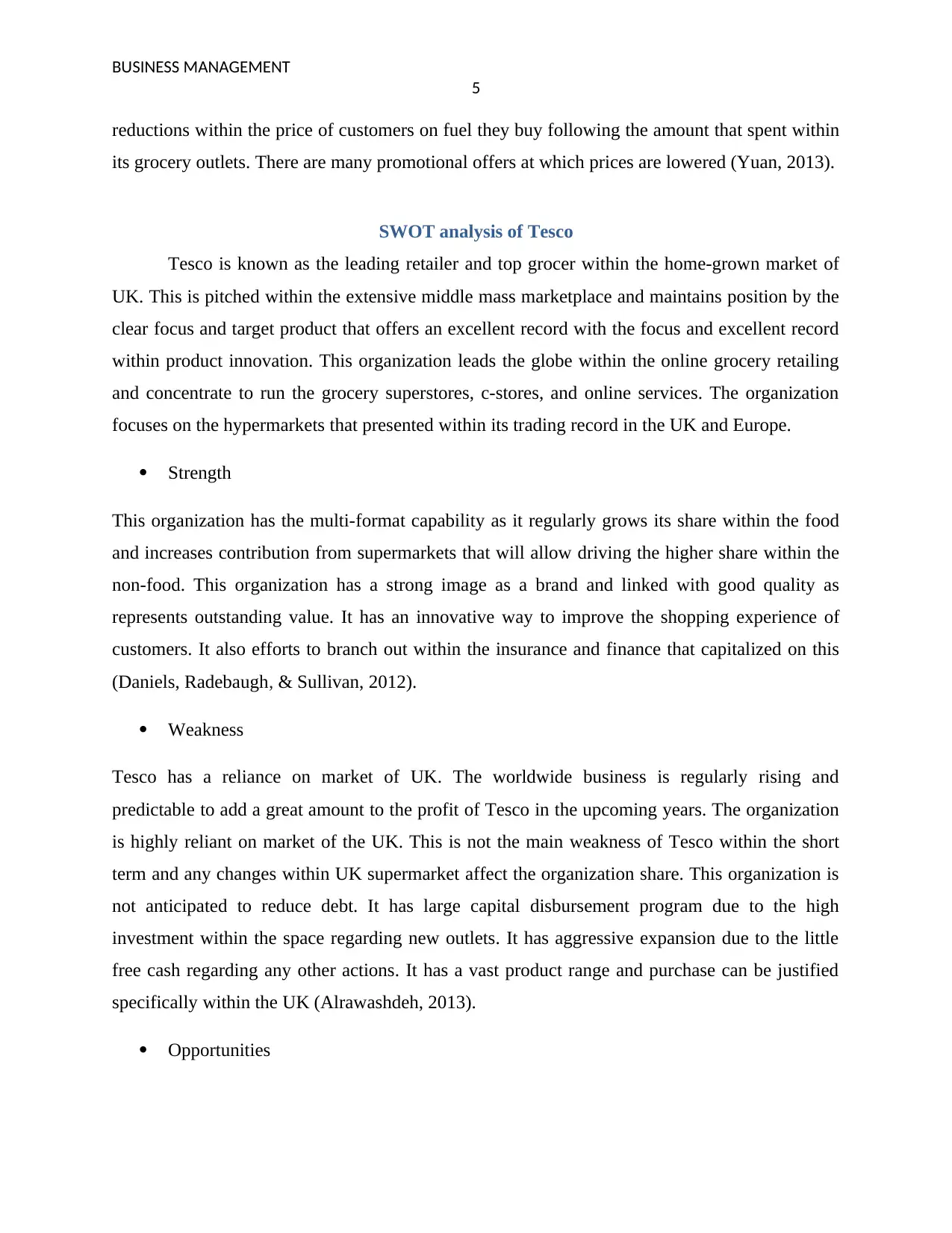
BUSINESS MANAGEMENT
5
reductions within the price of customers on fuel they buy following the amount that spent within
its grocery outlets. There are many promotional offers at which prices are lowered (Yuan, 2013).
SWOT analysis of Tesco
Tesco is known as the leading retailer and top grocer within the home-grown market of
UK. This is pitched within the extensive middle mass marketplace and maintains position by the
clear focus and target product that offers an excellent record with the focus and excellent record
within product innovation. This organization leads the globe within the online grocery retailing
and concentrate to run the grocery superstores, c-stores, and online services. The organization
focuses on the hypermarkets that presented within its trading record in the UK and Europe.
Strength
This organization has the multi-format capability as it regularly grows its share within the food
and increases contribution from supermarkets that will allow driving the higher share within the
non-food. This organization has a strong image as a brand and linked with good quality as
represents outstanding value. It has an innovative way to improve the shopping experience of
customers. It also efforts to branch out within the insurance and finance that capitalized on this
(Daniels, Radebaugh, & Sullivan, 2012).
Weakness
Tesco has a reliance on market of UK. The worldwide business is regularly rising and
predictable to add a great amount to the profit of Tesco in the upcoming years. The organization
is highly reliant on market of the UK. This is not the main weakness of Tesco within the short
term and any changes within UK supermarket affect the organization share. This organization is
not anticipated to reduce debt. It has large capital disbursement program due to the high
investment within the space regarding new outlets. It has aggressive expansion due to the little
free cash regarding any other actions. It has a vast product range and purchase can be justified
specifically within the UK (Alrawashdeh, 2013).
Opportunities
5
reductions within the price of customers on fuel they buy following the amount that spent within
its grocery outlets. There are many promotional offers at which prices are lowered (Yuan, 2013).
SWOT analysis of Tesco
Tesco is known as the leading retailer and top grocer within the home-grown market of
UK. This is pitched within the extensive middle mass marketplace and maintains position by the
clear focus and target product that offers an excellent record with the focus and excellent record
within product innovation. This organization leads the globe within the online grocery retailing
and concentrate to run the grocery superstores, c-stores, and online services. The organization
focuses on the hypermarkets that presented within its trading record in the UK and Europe.
Strength
This organization has the multi-format capability as it regularly grows its share within the food
and increases contribution from supermarkets that will allow driving the higher share within the
non-food. This organization has a strong image as a brand and linked with good quality as
represents outstanding value. It has an innovative way to improve the shopping experience of
customers. It also efforts to branch out within the insurance and finance that capitalized on this
(Daniels, Radebaugh, & Sullivan, 2012).
Weakness
Tesco has a reliance on market of UK. The worldwide business is regularly rising and
predictable to add a great amount to the profit of Tesco in the upcoming years. The organization
is highly reliant on market of the UK. This is not the main weakness of Tesco within the short
term and any changes within UK supermarket affect the organization share. This organization is
not anticipated to reduce debt. It has large capital disbursement program due to the high
investment within the space regarding new outlets. It has aggressive expansion due to the little
free cash regarding any other actions. It has a vast product range and purchase can be justified
specifically within the UK (Alrawashdeh, 2013).
Opportunities
⊘ This is a preview!⊘
Do you want full access?
Subscribe today to unlock all pages.

Trusted by 1+ million students worldwide
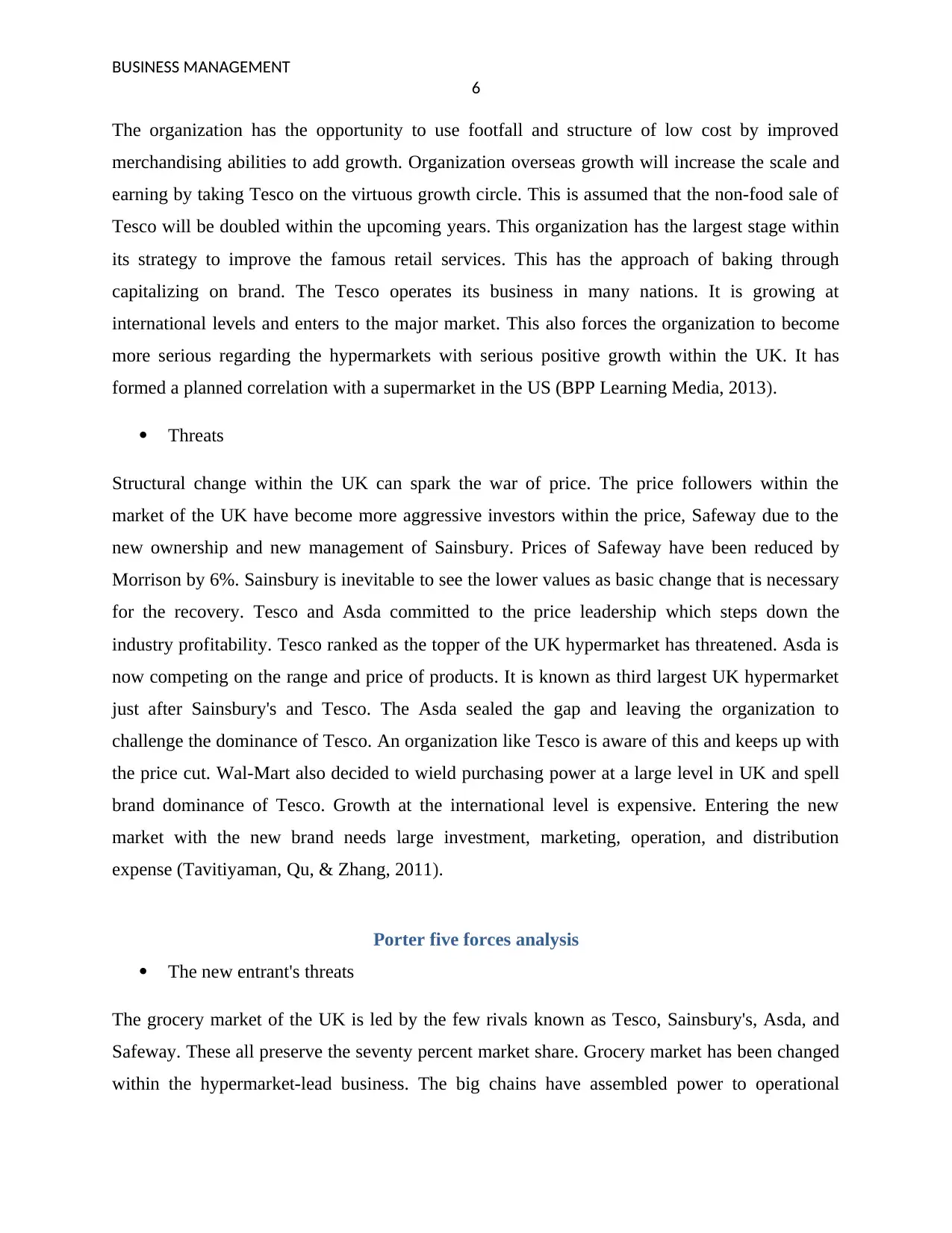
BUSINESS MANAGEMENT
6
The organization has the opportunity to use footfall and structure of low cost by improved
merchandising abilities to add growth. Organization overseas growth will increase the scale and
earning by taking Tesco on the virtuous growth circle. This is assumed that the non-food sale of
Tesco will be doubled within the upcoming years. This organization has the largest stage within
its strategy to improve the famous retail services. This has the approach of baking through
capitalizing on brand. The Tesco operates its business in many nations. It is growing at
international levels and enters to the major market. This also forces the organization to become
more serious regarding the hypermarkets with serious positive growth within the UK. It has
formed a planned correlation with a supermarket in the US (BPP Learning Media, 2013).
Threats
Structural change within the UK can spark the war of price. The price followers within the
market of the UK have become more aggressive investors within the price, Safeway due to the
new ownership and new management of Sainsbury. Prices of Safeway have been reduced by
Morrison by 6%. Sainsbury is inevitable to see the lower values as basic change that is necessary
for the recovery. Tesco and Asda committed to the price leadership which steps down the
industry profitability. Tesco ranked as the topper of the UK hypermarket has threatened. Asda is
now competing on the range and price of products. It is known as third largest UK hypermarket
just after Sainsbury's and Tesco. The Asda sealed the gap and leaving the organization to
challenge the dominance of Tesco. An organization like Tesco is aware of this and keeps up with
the price cut. Wal-Mart also decided to wield purchasing power at a large level in UK and spell
brand dominance of Tesco. Growth at the international level is expensive. Entering the new
market with the new brand needs large investment, marketing, operation, and distribution
expense (Tavitiyaman, Qu, & Zhang, 2011).
Porter five forces analysis
The new entrant's threats
The grocery market of the UK is led by the few rivals known as Tesco, Sainsbury's, Asda, and
Safeway. These all preserve the seventy percent market share. Grocery market has been changed
within the hypermarket-lead business. The big chains have assembled power to operational
6
The organization has the opportunity to use footfall and structure of low cost by improved
merchandising abilities to add growth. Organization overseas growth will increase the scale and
earning by taking Tesco on the virtuous growth circle. This is assumed that the non-food sale of
Tesco will be doubled within the upcoming years. This organization has the largest stage within
its strategy to improve the famous retail services. This has the approach of baking through
capitalizing on brand. The Tesco operates its business in many nations. It is growing at
international levels and enters to the major market. This also forces the organization to become
more serious regarding the hypermarkets with serious positive growth within the UK. It has
formed a planned correlation with a supermarket in the US (BPP Learning Media, 2013).
Threats
Structural change within the UK can spark the war of price. The price followers within the
market of the UK have become more aggressive investors within the price, Safeway due to the
new ownership and new management of Sainsbury. Prices of Safeway have been reduced by
Morrison by 6%. Sainsbury is inevitable to see the lower values as basic change that is necessary
for the recovery. Tesco and Asda committed to the price leadership which steps down the
industry profitability. Tesco ranked as the topper of the UK hypermarket has threatened. Asda is
now competing on the range and price of products. It is known as third largest UK hypermarket
just after Sainsbury's and Tesco. The Asda sealed the gap and leaving the organization to
challenge the dominance of Tesco. An organization like Tesco is aware of this and keeps up with
the price cut. Wal-Mart also decided to wield purchasing power at a large level in UK and spell
brand dominance of Tesco. Growth at the international level is expensive. Entering the new
market with the new brand needs large investment, marketing, operation, and distribution
expense (Tavitiyaman, Qu, & Zhang, 2011).
Porter five forces analysis
The new entrant's threats
The grocery market of the UK is led by the few rivals known as Tesco, Sainsbury's, Asda, and
Safeway. These all preserve the seventy percent market share. Grocery market has been changed
within the hypermarket-lead business. The big chains have assembled power to operational
Paraphrase This Document
Need a fresh take? Get an instant paraphrase of this document with our AI Paraphraser
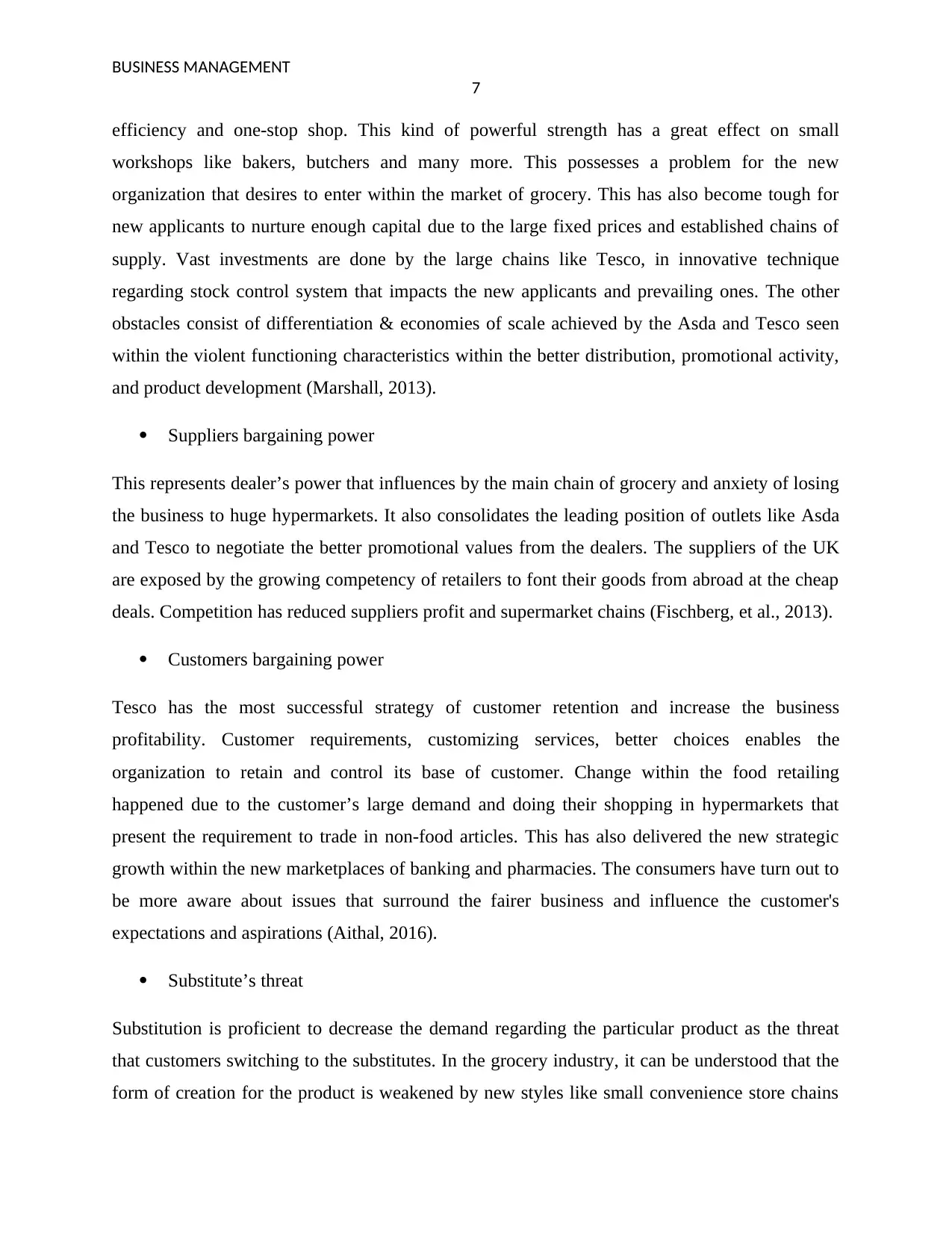
BUSINESS MANAGEMENT
7
efficiency and one-stop shop. This kind of powerful strength has a great effect on small
workshops like bakers, butchers and many more. This possesses a problem for the new
organization that desires to enter within the market of grocery. This has also become tough for
new applicants to nurture enough capital due to the large fixed prices and established chains of
supply. Vast investments are done by the large chains like Tesco, in innovative technique
regarding stock control system that impacts the new applicants and prevailing ones. The other
obstacles consist of differentiation & economies of scale achieved by the Asda and Tesco seen
within the violent functioning characteristics within the better distribution, promotional activity,
and product development (Marshall, 2013).
Suppliers bargaining power
This represents dealer’s power that influences by the main chain of grocery and anxiety of losing
the business to huge hypermarkets. It also consolidates the leading position of outlets like Asda
and Tesco to negotiate the better promotional values from the dealers. The suppliers of the UK
are exposed by the growing competency of retailers to font their goods from abroad at the cheap
deals. Competition has reduced suppliers profit and supermarket chains (Fischberg, et al., 2013).
Customers bargaining power
Tesco has the most successful strategy of customer retention and increase the business
profitability. Customer requirements, customizing services, better choices enables the
organization to retain and control its base of customer. Change within the food retailing
happened due to the customer’s large demand and doing their shopping in hypermarkets that
present the requirement to trade in non-food articles. This has also delivered the new strategic
growth within the new marketplaces of banking and pharmacies. The consumers have turn out to
be more aware about issues that surround the fairer business and influence the customer's
expectations and aspirations (Aithal, 2016).
Substitute’s threat
Substitution is proficient to decrease the demand regarding the particular product as the threat
that customers switching to the substitutes. In the grocery industry, it can be understood that the
form of creation for the product is weakened by new styles like small convenience store chains
7
efficiency and one-stop shop. This kind of powerful strength has a great effect on small
workshops like bakers, butchers and many more. This possesses a problem for the new
organization that desires to enter within the market of grocery. This has also become tough for
new applicants to nurture enough capital due to the large fixed prices and established chains of
supply. Vast investments are done by the large chains like Tesco, in innovative technique
regarding stock control system that impacts the new applicants and prevailing ones. The other
obstacles consist of differentiation & economies of scale achieved by the Asda and Tesco seen
within the violent functioning characteristics within the better distribution, promotional activity,
and product development (Marshall, 2013).
Suppliers bargaining power
This represents dealer’s power that influences by the main chain of grocery and anxiety of losing
the business to huge hypermarkets. It also consolidates the leading position of outlets like Asda
and Tesco to negotiate the better promotional values from the dealers. The suppliers of the UK
are exposed by the growing competency of retailers to font their goods from abroad at the cheap
deals. Competition has reduced suppliers profit and supermarket chains (Fischberg, et al., 2013).
Customers bargaining power
Tesco has the most successful strategy of customer retention and increase the business
profitability. Customer requirements, customizing services, better choices enables the
organization to retain and control its base of customer. Change within the food retailing
happened due to the customer’s large demand and doing their shopping in hypermarkets that
present the requirement to trade in non-food articles. This has also delivered the new strategic
growth within the new marketplaces of banking and pharmacies. The consumers have turn out to
be more aware about issues that surround the fairer business and influence the customer's
expectations and aspirations (Aithal, 2016).
Substitute’s threat
Substitution is proficient to decrease the demand regarding the particular product as the threat
that customers switching to the substitutes. In the grocery industry, it can be understood that the
form of creation for the product is weakened by new styles like small convenience store chains
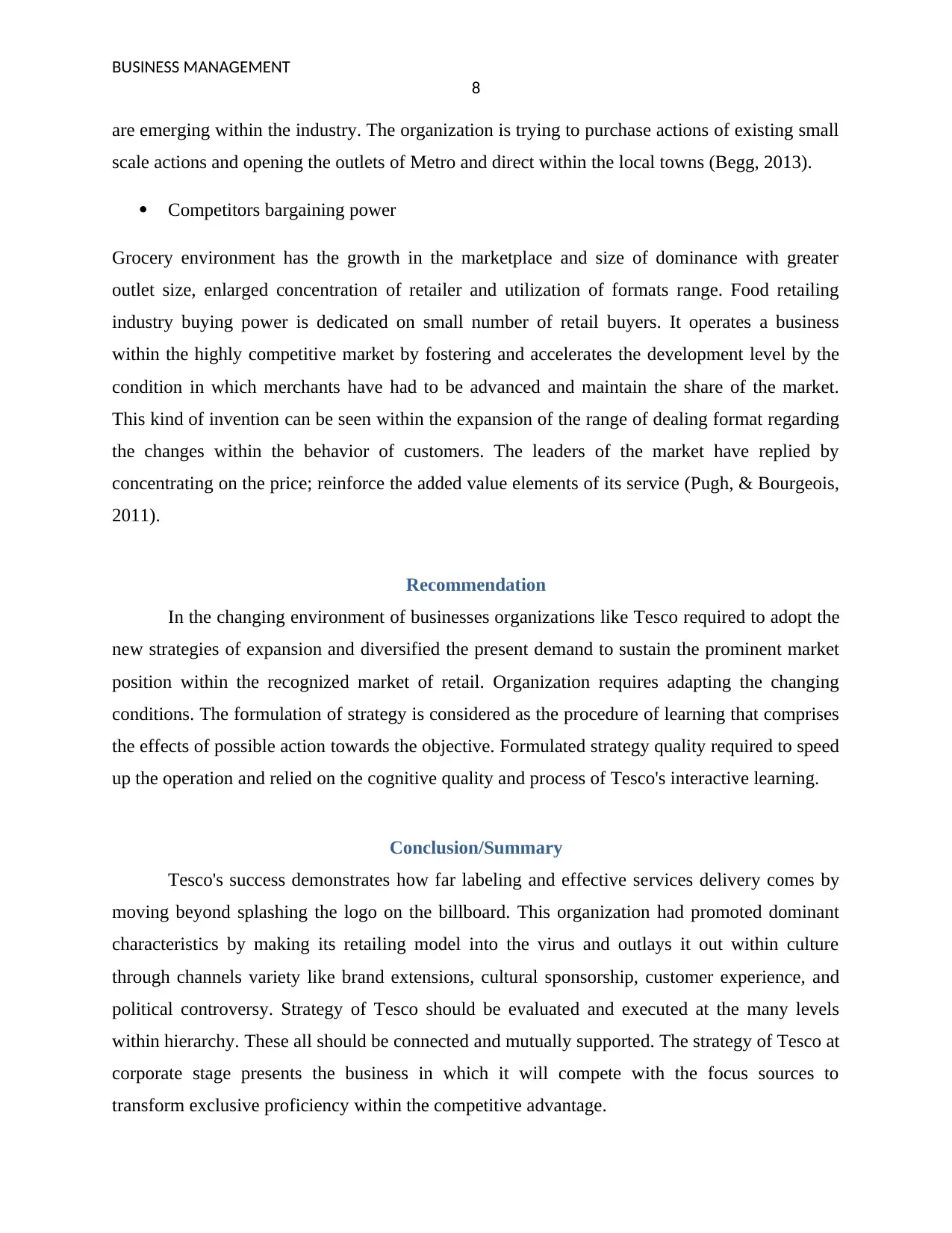
BUSINESS MANAGEMENT
8
are emerging within the industry. The organization is trying to purchase actions of existing small
scale actions and opening the outlets of Metro and direct within the local towns (Begg, 2013).
Competitors bargaining power
Grocery environment has the growth in the marketplace and size of dominance with greater
outlet size, enlarged concentration of retailer and utilization of formats range. Food retailing
industry buying power is dedicated on small number of retail buyers. It operates a business
within the highly competitive market by fostering and accelerates the development level by the
condition in which merchants have had to be advanced and maintain the share of the market.
This kind of invention can be seen within the expansion of the range of dealing format regarding
the changes within the behavior of customers. The leaders of the market have replied by
concentrating on the price; reinforce the added value elements of its service (Pugh, & Bourgeois,
2011).
Recommendation
In the changing environment of businesses organizations like Tesco required to adopt the
new strategies of expansion and diversified the present demand to sustain the prominent market
position within the recognized market of retail. Organization requires adapting the changing
conditions. The formulation of strategy is considered as the procedure of learning that comprises
the effects of possible action towards the objective. Formulated strategy quality required to speed
up the operation and relied on the cognitive quality and process of Tesco's interactive learning.
Conclusion/Summary
Tesco's success demonstrates how far labeling and effective services delivery comes by
moving beyond splashing the logo on the billboard. This organization had promoted dominant
characteristics by making its retailing model into the virus and outlays it out within culture
through channels variety like brand extensions, cultural sponsorship, customer experience, and
political controversy. Strategy of Tesco should be evaluated and executed at the many levels
within hierarchy. These all should be connected and mutually supported. The strategy of Tesco at
corporate stage presents the business in which it will compete with the focus sources to
transform exclusive proficiency within the competitive advantage.
8
are emerging within the industry. The organization is trying to purchase actions of existing small
scale actions and opening the outlets of Metro and direct within the local towns (Begg, 2013).
Competitors bargaining power
Grocery environment has the growth in the marketplace and size of dominance with greater
outlet size, enlarged concentration of retailer and utilization of formats range. Food retailing
industry buying power is dedicated on small number of retail buyers. It operates a business
within the highly competitive market by fostering and accelerates the development level by the
condition in which merchants have had to be advanced and maintain the share of the market.
This kind of invention can be seen within the expansion of the range of dealing format regarding
the changes within the behavior of customers. The leaders of the market have replied by
concentrating on the price; reinforce the added value elements of its service (Pugh, & Bourgeois,
2011).
Recommendation
In the changing environment of businesses organizations like Tesco required to adopt the
new strategies of expansion and diversified the present demand to sustain the prominent market
position within the recognized market of retail. Organization requires adapting the changing
conditions. The formulation of strategy is considered as the procedure of learning that comprises
the effects of possible action towards the objective. Formulated strategy quality required to speed
up the operation and relied on the cognitive quality and process of Tesco's interactive learning.
Conclusion/Summary
Tesco's success demonstrates how far labeling and effective services delivery comes by
moving beyond splashing the logo on the billboard. This organization had promoted dominant
characteristics by making its retailing model into the virus and outlays it out within culture
through channels variety like brand extensions, cultural sponsorship, customer experience, and
political controversy. Strategy of Tesco should be evaluated and executed at the many levels
within hierarchy. These all should be connected and mutually supported. The strategy of Tesco at
corporate stage presents the business in which it will compete with the focus sources to
transform exclusive proficiency within the competitive advantage.
⊘ This is a preview!⊘
Do you want full access?
Subscribe today to unlock all pages.

Trusted by 1+ million students worldwide
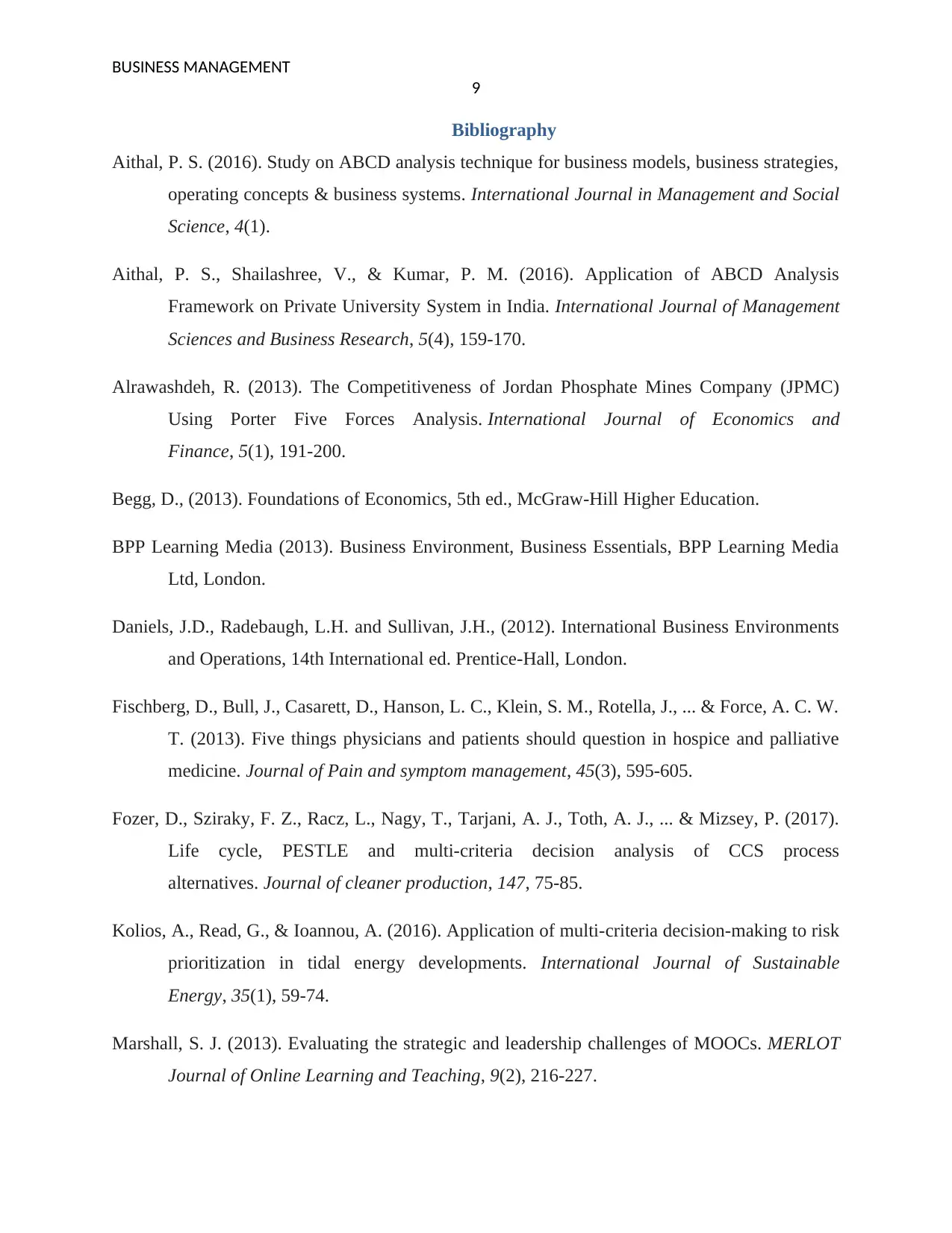
BUSINESS MANAGEMENT
9
Bibliography
Aithal, P. S. (2016). Study on ABCD analysis technique for business models, business strategies,
operating concepts & business systems. International Journal in Management and Social
Science, 4(1).
Aithal, P. S., Shailashree, V., & Kumar, P. M. (2016). Application of ABCD Analysis
Framework on Private University System in India. International Journal of Management
Sciences and Business Research, 5(4), 159-170.
Alrawashdeh, R. (2013). The Competitiveness of Jordan Phosphate Mines Company (JPMC)
Using Porter Five Forces Analysis. International Journal of Economics and
Finance, 5(1), 191-200.
Begg, D., (2013). Foundations of Economics, 5th ed., McGraw-Hill Higher Education.
BPP Learning Media (2013). Business Environment, Business Essentials, BPP Learning Media
Ltd, London.
Daniels, J.D., Radebaugh, L.H. and Sullivan, J.H., (2012). International Business Environments
and Operations, 14th International ed. Prentice-Hall, London.
Fischberg, D., Bull, J., Casarett, D., Hanson, L. C., Klein, S. M., Rotella, J., ... & Force, A. C. W.
T. (2013). Five things physicians and patients should question in hospice and palliative
medicine. Journal of Pain and symptom management, 45(3), 595-605.
Fozer, D., Sziraky, F. Z., Racz, L., Nagy, T., Tarjani, A. J., Toth, A. J., ... & Mizsey, P. (2017).
Life cycle, PESTLE and multi-criteria decision analysis of CCS process
alternatives. Journal of cleaner production, 147, 75-85.
Kolios, A., Read, G., & Ioannou, A. (2016). Application of multi-criteria decision-making to risk
prioritization in tidal energy developments. International Journal of Sustainable
Energy, 35(1), 59-74.
Marshall, S. J. (2013). Evaluating the strategic and leadership challenges of MOOCs. MERLOT
Journal of Online Learning and Teaching, 9(2), 216-227.
9
Bibliography
Aithal, P. S. (2016). Study on ABCD analysis technique for business models, business strategies,
operating concepts & business systems. International Journal in Management and Social
Science, 4(1).
Aithal, P. S., Shailashree, V., & Kumar, P. M. (2016). Application of ABCD Analysis
Framework on Private University System in India. International Journal of Management
Sciences and Business Research, 5(4), 159-170.
Alrawashdeh, R. (2013). The Competitiveness of Jordan Phosphate Mines Company (JPMC)
Using Porter Five Forces Analysis. International Journal of Economics and
Finance, 5(1), 191-200.
Begg, D., (2013). Foundations of Economics, 5th ed., McGraw-Hill Higher Education.
BPP Learning Media (2013). Business Environment, Business Essentials, BPP Learning Media
Ltd, London.
Daniels, J.D., Radebaugh, L.H. and Sullivan, J.H., (2012). International Business Environments
and Operations, 14th International ed. Prentice-Hall, London.
Fischberg, D., Bull, J., Casarett, D., Hanson, L. C., Klein, S. M., Rotella, J., ... & Force, A. C. W.
T. (2013). Five things physicians and patients should question in hospice and palliative
medicine. Journal of Pain and symptom management, 45(3), 595-605.
Fozer, D., Sziraky, F. Z., Racz, L., Nagy, T., Tarjani, A. J., Toth, A. J., ... & Mizsey, P. (2017).
Life cycle, PESTLE and multi-criteria decision analysis of CCS process
alternatives. Journal of cleaner production, 147, 75-85.
Kolios, A., Read, G., & Ioannou, A. (2016). Application of multi-criteria decision-making to risk
prioritization in tidal energy developments. International Journal of Sustainable
Energy, 35(1), 59-74.
Marshall, S. J. (2013). Evaluating the strategic and leadership challenges of MOOCs. MERLOT
Journal of Online Learning and Teaching, 9(2), 216-227.
Paraphrase This Document
Need a fresh take? Get an instant paraphrase of this document with our AI Paraphraser
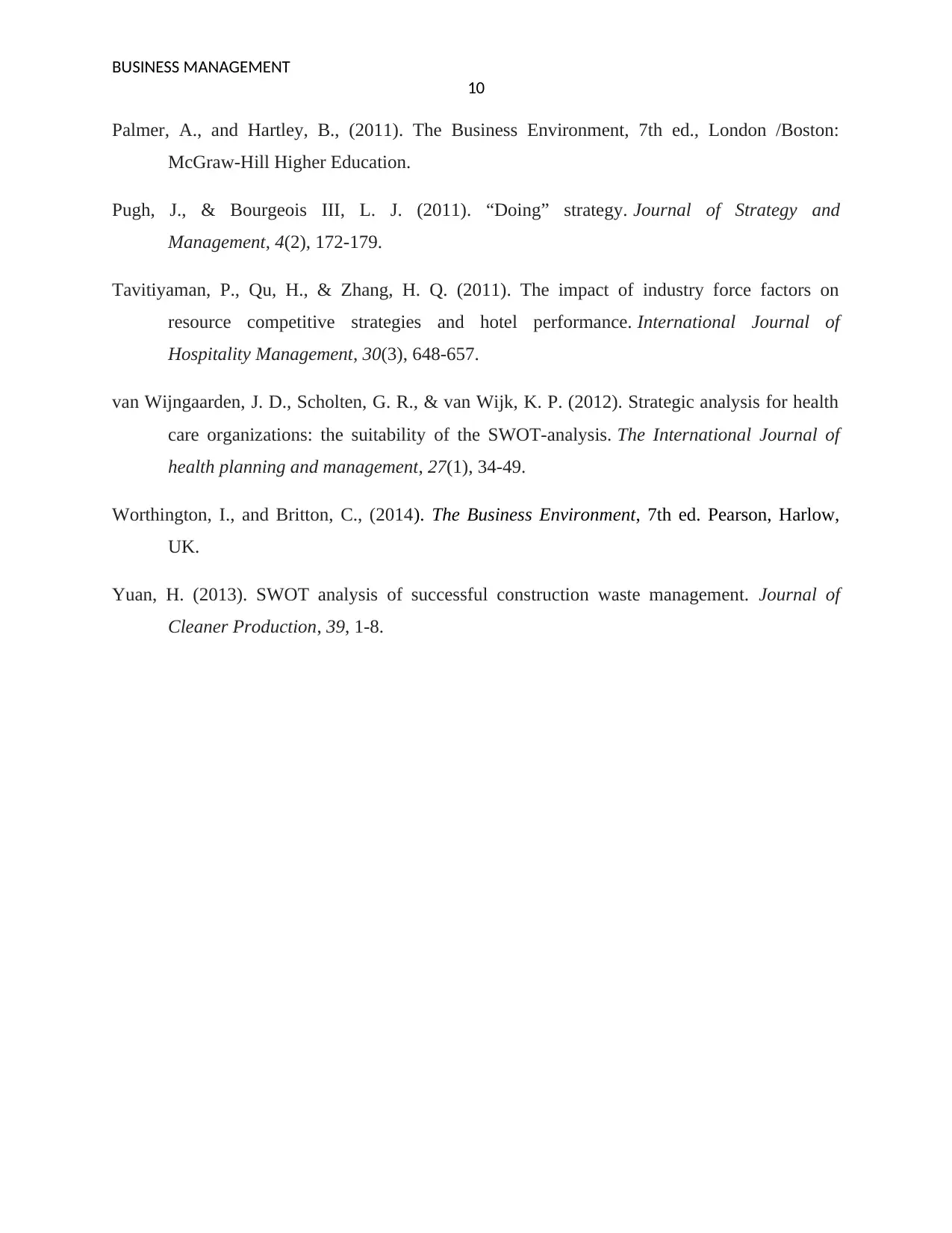
BUSINESS MANAGEMENT
10
Palmer, A., and Hartley, B., (2011). The Business Environment, 7th ed., London /Boston:
McGraw-Hill Higher Education.
Pugh, J., & Bourgeois III, L. J. (2011). “Doing” strategy. Journal of Strategy and
Management, 4(2), 172-179.
Tavitiyaman, P., Qu, H., & Zhang, H. Q. (2011). The impact of industry force factors on
resource competitive strategies and hotel performance. International Journal of
Hospitality Management, 30(3), 648-657.
van Wijngaarden, J. D., Scholten, G. R., & van Wijk, K. P. (2012). Strategic analysis for health
care organizations: the suitability of the SWOT‐analysis. The International Journal of
health planning and management, 27(1), 34-49.
Worthington, I., and Britton, C., (2014). The Business Environment, 7th ed. Pearson, Harlow,
UK.
Yuan, H. (2013). SWOT analysis of successful construction waste management. Journal of
Cleaner Production, 39, 1-8.
10
Palmer, A., and Hartley, B., (2011). The Business Environment, 7th ed., London /Boston:
McGraw-Hill Higher Education.
Pugh, J., & Bourgeois III, L. J. (2011). “Doing” strategy. Journal of Strategy and
Management, 4(2), 172-179.
Tavitiyaman, P., Qu, H., & Zhang, H. Q. (2011). The impact of industry force factors on
resource competitive strategies and hotel performance. International Journal of
Hospitality Management, 30(3), 648-657.
van Wijngaarden, J. D., Scholten, G. R., & van Wijk, K. P. (2012). Strategic analysis for health
care organizations: the suitability of the SWOT‐analysis. The International Journal of
health planning and management, 27(1), 34-49.
Worthington, I., and Britton, C., (2014). The Business Environment, 7th ed. Pearson, Harlow,
UK.
Yuan, H. (2013). SWOT analysis of successful construction waste management. Journal of
Cleaner Production, 39, 1-8.
1 out of 11
Related Documents
Your All-in-One AI-Powered Toolkit for Academic Success.
+13062052269
info@desklib.com
Available 24*7 on WhatsApp / Email
![[object Object]](/_next/static/media/star-bottom.7253800d.svg)
Unlock your academic potential
Copyright © 2020–2025 A2Z Services. All Rights Reserved. Developed and managed by ZUCOL.




